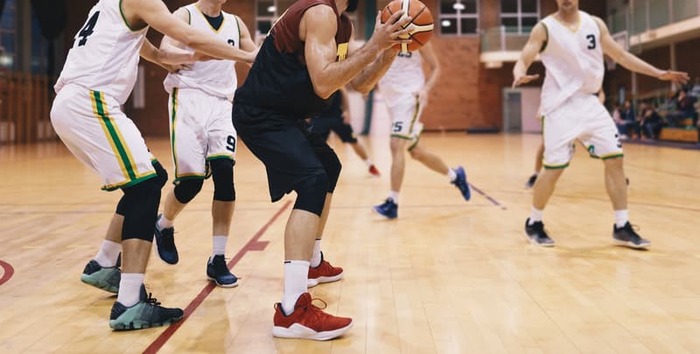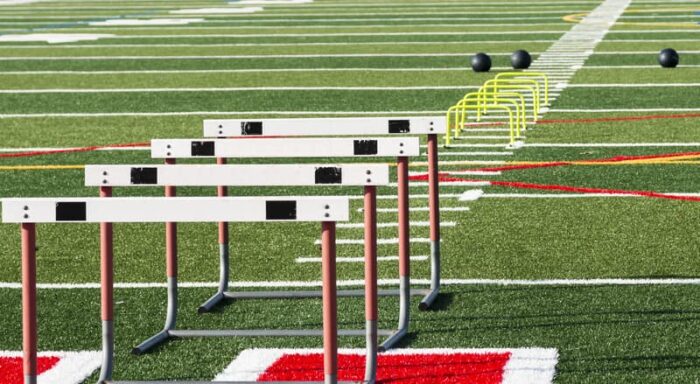- Calls to this hotline are currently being directed to Within Health or Eating Disorder Solutions
- Representatives are standing by 24/7 to help answer your questions
- All calls are confidential and HIPAA compliant
- There is no obligation or cost to call
- Eating Disorder Hope does not receive any commissions or fees dependent upon which provider you select
- Additional treatment providers are located on our directory or samhsa.gov
Eating Disorders in Athletes
Athletes are uniquely vulnerable to disordered eating and exercise behaviors due to the relationship their athletic performance may have with their nutritional intake and training schedule. Understanding the risks athletes face is key to providing preventative support and coaching. This can help to reduce the likelihood of eating disorder development as well as increase the likelihood of early intervention and, therefore, long-term recovery.
Athletes with Eating Disorders Statistics
Due to the increased vulnerability of this population, many studies have been conducted to learn more information about athletes and eating disorders. Through this research, the following has been learned:
- 13.5% of athletes struggle with an eating disorder [1].
- Up to 45% of female athletes, and 19% of male athletes, struggle with an eating disorder [2].
- Among high school students, rates of eating disorders among athletes is higher than non-athletes, with 7.3% of athletes affected and 2.3% of non-athletes impacted [3].
- 2% of female athletes struggle with anorexia nervosa [4].
- 6% of female, and 2% of male, athletes will struggle with bulimia nervosa behaviors [4].
Related Reading
What are the Signs of Eating Disorders?
The warning signs of eating disorder behaviors in athletes are difficult to distinguish because they are often glorified regardless of the sport one is competing in. Traits such as fueling the body with “healthy” foods, obsessing over what one consumes, or training long and arduous hours outside of practice are all celebrated but are just a few signs that an athlete is in trouble.
Eating disorders cause dangerous consequences for all individuals, however, this may present differently in athletes. For example, athletes struggling with disorders eating are at higher risk for RED-S, “Relative Energy Deficiency in Sport,” which “occurs when energy expenditure exceeds energy intake, creating an energy deficiency and a resulting compromise in health systems evidenced in one or more of the following: metabolism, menstrual function, bone health, immunity, protein synthesis, cardiovascular health and psychological health [3].”
Below are signs that an individual may be struggling with a specific eating disorder. If your athlete presents with these, regardless of the “culture” of your sport, it is important to ask some questions.
Anorexia Nervosa in Athletes
Anorexia nervosa refers to behaviors of severely restricting food intake. Athletes in aesthetic sports, that is, those that emphasize body appearance, are often seen engaging in these behaviors. Signs of disordered eating and exercising that may point to anorexia nervosa are:
- Fixation on body weight, shape or size.
- Calorie counting.
- Intense fear of gaining weight.
- Preoccupation on contents and nutritional aspects of food.
- Declining/skipping meals.
- Refusing to eat in front of others.
- Food rules.
- Distorted body image.
- Participation in an aesthetic sport (dance, gymnastics, figure skating, wrestling, equestrianism).
- Unusual food behaviors.
- Reported lethargy, difficulty with stamina.
- Impaired concentration.
Bulimia in Athletes
Bulimia nervosa involves individuals engaging in binge eating followed by compensatory behaviors such as purging, fasting, or excessive exercise. As noted above, this disorder is more common in athletes than anorexia nervosa as they require increased nourishment to fuel their activities yet may continue to struggle with appearance or weight due to sport requirements as well. The following may signify an athlete is engaging in bulimic behaviors:
- Binge eating behaviors after practice, interrupted or followed by trips to the bathroom.
- Eating in secret.
- Hiding food.
- Preoccupation with body weight/shape/size.
- Distorted body image.
- Eating beyond fullness.
- Expressing shame or guilt around eating.
- Possessing/purchasing diuretics and/laxatives.
- Excessive coffee drinking/fluid consumption.
- Scarring on the knuckles.
Binge Eating in Athletes
Finally, Binge Eating Disorder (BED) in athletes is common, particularly if they are engaging in restrictive behaviors or simply not nourishing their bodies properly in accordance with their energy output. Be aware of the following signs of binge eating:
- Eating in secret.
- Hiding food.
- Expressing shame/guilt around food and/or eating.
- Eating at a fast pace.
- Reported feelings of depression or low self-worth.
- Nourishment in public is observed to be inappropriate with the amount of energy output.
- Weight fluctuations.
- Lethargy.
Long-Term Effects of Eating Disorders on Athletes
The long-term impact of eating disorder behaviors on an athlete can be severe, as their energy output requires proper nourishment and optimal body functioning, both of which are impaired by an eating disorder.
The negative impacts of eating disorder behaviors on the female athlete are so common that treatment professionals refer to them as “Female Athlete Triad” syndrome, which specifies three consequences as “menstrual dysfunction, low energy availability, and reduced bone mineral density [1]. Approximately 4.3% of female athletes struggle with this syndrome [1].
The following consequences can occur long-term if an athlete is not treated for disordered eating behaviors:
- Metabolic imbalances.
- Increased risk of athletic injury.
- Poor sports performance.
- Inability to perform sports requirements resulting in quitting/retirement.
- Decreased training response.
- Impaired judgment.
- Decreased coordination.
- Impaired aerobic functioning.
- Damage to vital organs.
- Loss of menstrual cycle/infertility issues.
- Increased risk of heart failure and cardiovascular complications.
- Bone and muscle loss.
- Ulcers.
- Gastrointestinal complications.
- Tooth decay/gum disease/tooth loss.
- Increased depression/anxiety.
- Increased risk of substance abuse.
- Increased suicidal thoughts.
- Death.
Causes of Eating Disorders
Eating disorders do not have one distinct cause, as numerous biological, psychological, and social factors contribute to their development. Athletes do experience unique vulnerability factors that make them more likely to engage in disordered eating or exercising behaviors due to the requirements of their sport and the pressure to perform.
There are sports more likely to cause disordered eating and exercise behaviors, particularly those in which appearance is emphasized. For women, the 3 athletic activities that place them most at-risk for disordered eating are gymnastics, dancing, and figure skating. For men, these activities are wrestling, equestrianism, and body-building. The pressure in these sports to not only perform but appear a certain way increases the chance of eating disorder development.
The culture of sports alone can also make an athlete more susceptible to distorted body image and disordered eating beliefs. One study detailed the following sports-culture risk factors that may contribute to disordered eating: “endurance, weight category…the revealing nature of much sports clothing, the intense competitiveness of sports participants which can extend to ‘competitive thinness’, specialising in one sport at an early age and sudden increases in training volume [4].”
These factors and the pressure to perform successfully, and often achieve a certain appearance while doing so, make athletes more at-risk to have distorted body beliefs and engage in disordered eating and exercise behaviors.
Helping Athletes with Eating Disorders
Treating athletes with eating disorders is not very different from treating non-athletes. In fact, the evidence-based treatments recommended such as Cognitive Behavioral Therapy (CBT), Dialectical Behavior Therapy (DBT) and Family Based Treatment are still advised for athletes.
The most important aspect in supporting athletes struggling with disordered eating and exercise behaviors is to prioritize the athlete over the sport. Treatment takes time and commitment to be effective and an athlete cannot commit both to their sport and their recovery at the same time.
It will likely be necessary for the athlete to take some time off to solely focus on treatment and eating disorder recovery. While this can be difficult for the athlete, doing this increases their likelihood of being able to safely return to the sport they are passionate about.
Prioritize your athlete over the game, competition, or event by encouraging them to play the long game for their health, body, and future.
Prevention Help
Tips for women on how to avoid eating disorder behaviors while training:
- exercise and train with a partner or in groups with other women (avoid isolation and secrecy around exercise and food);
- replenish fluids and follow a well-balanced food plan (including enough protein, iron, calcium, and fat intake);
- get guidance and help from a sports nutritionist;
- contact your physician if you begin to experience menstrual irregularity or lose menses;
- take 1-2 days off per week;
- avoid looking at “calories burned” displays on cardio equipment;
- seek professional help if you start to experience unmanageability in your eating, exercise, or weight and/or body concerns;
- avoid using diuretics, laxatives, stimulants, steroids for performance or training enhancement;
- Women with histories of eating disorder: continue to receive maintenance care from a professional; continue to attend support groups for people in recovery from eating disorders.
Tips for coaches and school administration:
- provide education around prevention and recognition of eating disorders particularly to staff and coaches for female athletes;
- provide education around prevention and recognition of eating disorders to female athletes;
- make appropriate treatment recommendations for athletes who are suspected of having an illness;
- work with treatment team professionals to set clear expectations around necessary recovery parameters to resume or maintain athletic participation;
- foster a culture of safety around the athlete asking for help and expressing concerns about weight;
- allow for and enable a female athlete to express when a training schedule feels like too much or feels too intense;
- be part of the solution, rather than part of the problem (denial, shaming, etc.).
Athletes & Eating Disorders Articles
- Running is a way to keep healthy. However, long-distance runners are at higher risk of developing an eating disorder. There is a fallacy that many athletes believe and that is lower body weight means better performance. This particular idea has not been proven but it still remains prevalent in endurance running.
- Being an athlete, particularly those that participate in elite or judged sports, such as gymnastics or distance running, can encompass rigorous physical demands. As a result, the risk of developing an eating disorder can be more prominent in this population. For athletes struggling with any form of an eating disorder, the effects are debilitating. With an adequate treatment plan, unfaltering support system, and with the love of the sport, the prognosis for athletes in recovery can be successful. Learn more about the dangers for athletes with eating disorders in this article.
- In the effort to treat eating disorders, many health professionals utilize Cognitive Behavioral Therapy as well as Dialectical Behavioral Therapy. Yet as treatment programs face increasing competition, clinicians are emphasizing the potential benefits of supplementing such therapeutic mechanisms with alternative approaches. A recent study concerning the effect of yoga on psychological functioning in women with a history of disordered eating reported that modalities, such as yoga, offer potential benefits for improving mood and other psychological states. Learn more about alternative methods to eating disorder treatment.
Resources:
[1] Ghoch, M. E., et al. (2013). Eating disorders, physical fitness, and sport performance: a systematic review. Nutrients, 5:12.[2] Conviser, J. H., Schlitzer Tierney, A., Nickols, R. (2018). Essential for best practice: treatment approaches for athletes with eating disorders. Journal of Clinical Sports Psychology, 12.
[3] Conviser, J. H., Schlitzer Tierney, A., Nickols, R. (2018). Assessment of Athletes with eating disorders: essentials for best practice. Journal of Clinical Sports Psychology, 12.
[4] Currie, A. (2010). Sports and eating disorders – understanding and managing the risks.Asian Journal of Sports Medicine, 1:2.
Author: Margot Rittenhouse, MS, NCC
Page Last Reviewed and Updated By: Jacquelyn Ekern, MS, LPC on August 16, 2021
Updates Pending July, 2022


